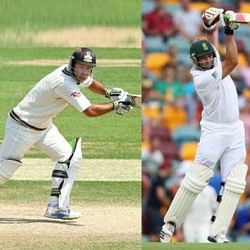
The invaluable No. 3 spot - Greats and challenges

Legends: The No.3 batsmen
What do Rahul Dravid, Ricky Ponting, Kumar Sangakkara and Jacques Kallis have in common? Yes, they were great players during their era which is a given, but there was one more factor that connects all these legendary players. It was the number 3 position that they immortalized while they played and made its importance paramount in the game of cricket. For those thinking of Brian Lara, he did bat at three and got his legendary 400 not out from the same position, but most of his career, he batter at number four and also scored 23 of his 34 hundreds from that position.
The position of a number three acts as a link between the openers and the middle order. He is supposed to adapt to all sorts of situations, whether it is an early wicket or a flying start, he is supposed to drop anchor and let the other players play around him. This is something which Rahul Dravid and Sangakkara did with aplomb, while Kallis, Ponting were known for their natural game of mixing caution with aggression.
What’s more common between Dravid, Punter, Sanga and Kallis is that they all started their careers by batting in the middle order and gradually were promoted to number 3, which is a key position in both Tests and the one day games. Who can forget the memorable but heartbreaking 95 scored by Dravid, batting at Lord’s at number seven on his Test debut!
Another thing to notice is that almost all these batsmen were excellent fielders behind the stumps, whether as a keeper or at first slip. Dravid holds the record for the maximum number of catches in the slips (210), a record unlikely to be broken for a while since his closest competition Kallis (200) has also hung up his boots. Dravid was also a pretty good wicket keeper in the one day game when India struggled to find a permanent keeper, but that was before Mahendra Singh Dhoni arrived. The rest is history.
Having good openers immediately rubs off on the number three batsman. Ricky Ponting was at his prime since he had able openers in the form of Matthew Hayden and Justin Langer in Tests and Adam Gilchrist in the shorter version of the game. A belligerent Virender Sehwag during his hey days was a perfect foil for Dravid who consolidated extremely well to a flying start. Similar was the case with Sanga, who had the privilege of having Sanath Jayasuriya at the top who could rip apart any bowling attack single handedly.
The success of the number three was also directly proportional to the success of the team. Dravid played a huge hand when India started its resurgence overseas in the early 2000s. He scored tons of runs (literally) in the drawn Test series in England and Australia (including double hundreds at Adelaide and The Oval).
Ponting was instrumental to drive Australia to the number one rankings both in Tests and ODIs and also to three successive World Cup titles. Kallis was the rock for South Africa when they became the number one Test side. However, he batted in the middle order during the twilight of his Test career once Hashim Amla cemented the number three spot as his.
Dravid, Ponting and Kallis are now enjoying lives post their glorious careers while their teams have tried to find their replacements. However, stepping into their shoes won’t be easy.
But India has been lucky in that regard as they have found an equally solid Cheteshwar Pujara in Tests and Virat Kohli in ODIs who can chase down any total set by the opposition if he wishes to. The 19 hundreds scored by him in ODIs (17 in a winning cause) bear testimony to this. Hashim Amla has done well for the Proteas. Unfortunately, the Aussies have not been able to find a suitable replacement for Punter as yet in spite of experimenting with many batsmen like Shaun Marsh, Usman Khawaja, and the more recent Alex Doolan.
These legends surely have raised the standards for a number three batsman and stepping into their big boots is surely going to be a tough task for these young Turks. A bow to the greats of the game.